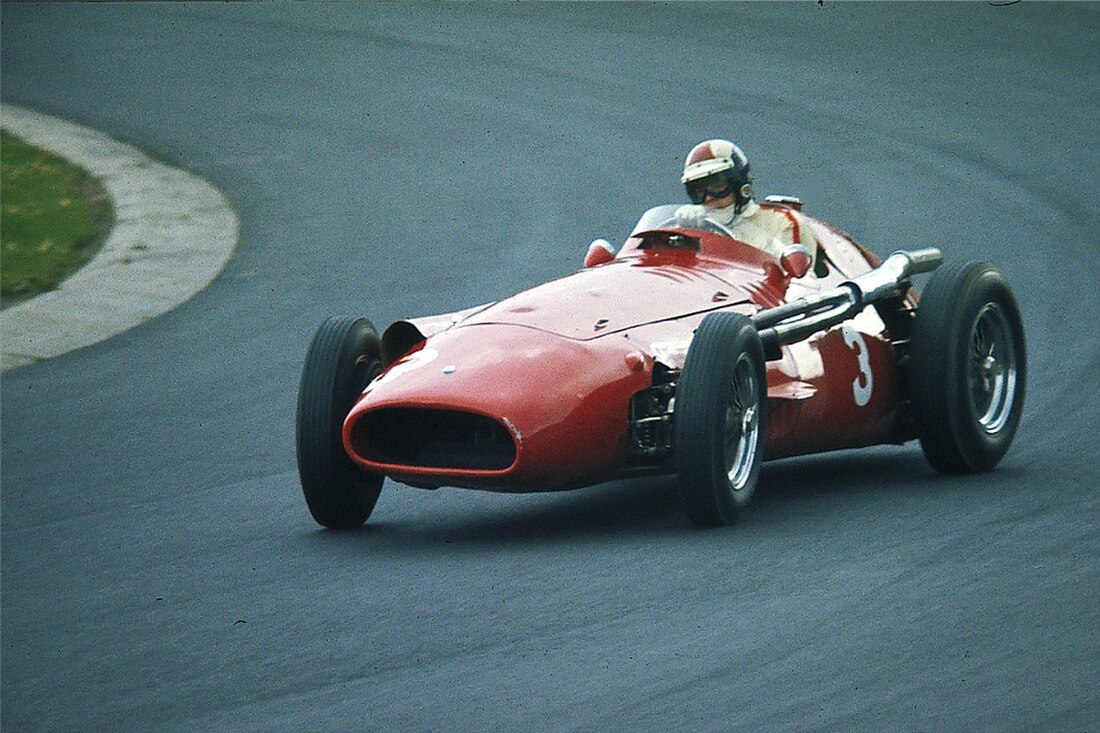Top Qs
Timeline
Chat
Perspective
Maserati 250F
Formula One car (1954–1960) From Wikipedia, the free encyclopedia
Remove ads
The Maserati 250F was a racing car made by Maserati of Italy used in '2.5 litre' Formula One racing between January 1954 and November 1960. Twenty-six examples were made.

Remove ads
Mechanical details
The 250F principally used the SSG, 220 bhp (at 7400rpm) 2,493 cc (152.1 cu in) capacity 84 mm × 75 mm (3.31 in × 2.95 in) Maserati A6 straight-six engine, ribbed 13.4" drum brakes, wishbone independent front suspension, a De Dion tube axle, Borrani 16" & 17" wheels and Pirelli Stella Bianca tyres. It was built by Gioacchino Colombo, Vittorio Bellentani and Alberto Massimino; the tubular work was by Valerio Colotti. A streamlined version with bodywork which partially enclosed the wheels (similar to the 1954 Mercedes-Benz W196 "Typ Monza") was used in the 1956 French Grand Prix.[1]
Remove ads
Images
- Maserati 250F
- straight 6 Maserati 250 F
- Cockpit
- Works team at Aintree, 1957
- Fangio and 250F
- Maserati 250F v12 at the Umberto Panini museum
Racing history
Summarize
Perspective
The 250F first raced in the 1954 Argentine Grand Prix where Juan Manuel Fangio won the first of his two victories before he left for the new Mercedes-Benz team. Fangio won the 1954 Drivers' World Championship, with points gained with both Maserati and Mercedes-Benz; Stirling Moss raced his own privately owned 250F for the full 1954 season. Prince Bira was another driver favouring the 250F.[citation needed]
In 1955 a 5-speed gearbox; SU fuel injection (240 bhp) and Dunlop disc brakes were introduced. Jean Behra drove this in a five-member works team which included Luigi Musso.[citation needed]
In 1956 Stirling Moss won the Monaco and Italian Grands Prix, both in a works car.[citation needed]
In 1956 three 250F T2 cars first appeared for the works drivers. Developed by Giulio Alfieri using lighter steel tubes they sported a slimmer, stiffer body and sometimes the new 315 bhp (235 kW) V12 engine of 2,491 cc (152.0 cu in) capacity 68.7 mm × 56 mm (2.70 in × 2.20 in), although it offered little or no real advantage over the older straight 6. It was later developed into the 3 litre V12 that won two races powering the Cooper T81 and T86 from 1966 to 1969,[2] the final "Tipo 10" variant of the engine having three valves and two spark plugs per cylinder.[citation needed]
In 1957 Juan Manuel Fangio drove to four more championship victories, including his final win at German Grand Prix at the Nürburgring (Aug. 4, 1957), where he overcame a 48-second deficit in 22 laps, passing the race leader, Mike Hawthorn, on the final lap to take the win. In doing so he broke the lap record at the Nürburgring, 10 times.[citation needed]
By the 1958 season, the 250F was totally outclassed by the new rear engined F1 cars. However, the car remained a favourite with the privateers, including Maria Teresa de Filippis, and was used by back markers through the 1960 F1 season, the last for the 2.5 litre formula.[citation needed]
In total, the 250F competed in 46 Formula One championship races with 277 entries, leading to eight wins. Success was not limited to World Championship events with 250F drivers winning many non-championship races around the world.[citation needed]
Stirling Moss later said that the 250F was the best front-engined F1 car he drove.[3]
World Championship wins
Non-World Championship wins
Remove ads
References
External links
Wikiwand - on
Seamless Wikipedia browsing. On steroids.
Remove ads








